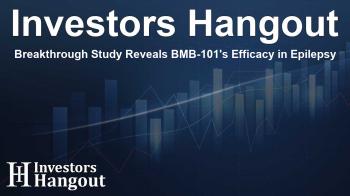Breakthrough Study Reveals BMB-101's Efficacy in Epilepsy

Exciting Developments in Epilepsy Treatment
Bright Minds Biosciences Inc. (CSE: DRUG) (NASDAQ: DRUG) has recently unveiled promising results from its study involving the DBA/2 mouse model, which is particularly significant for understanding and treating epilepsy. The study has shown that BMB-101, a novel 5-HT2C Gq-protein biased agonist, successfully eliminated drop attacks in these mice, a notable achievement in epilepsy research.
The Importance of the DBA/2 Mouse Model
The DBA/2 mouse model is an essential tool for epilepsy research, known for its predictive capabilities regarding sudden unexpected death in epilepsy (SUDEP). This model exhibits characteristics of human epilepsy, exhibiting drop attacks and other seizure activities that can inform the effectiveness of anti-epileptic drugs (AEDs). The results indicate that BMB-101 achieved a remarkable milestone, showing complete prevention of drop attacks in these experimental subjects, which translates into potential benefits for real-world neurological conditions.
Significant Findings for SUDEP Prevention
Research has highlighted BMB-101’s potential to fill significant gaps in the prevention of SUDEP, which is a leading cause of premature death among patients suffering from drug-resistant epilepsy. Current estimates indicate that the risk of sudden death in epilepsy patients can be a staggering 15-20%, especially for those with conditions like Dravet syndrome. These findings present a beacon of hope for improving outcomes and reducing mortality rates in vulnerable patient populations.
The Mechanism Behind BMB-101
BMB-101 is a sophisticated agent developed using state-of-the-art structure-based drug design methodologies. This agent has been explicitly curated to address chronic neurological issues, particularly where conventional treatments often fail due to tolerance or resistance. A vital feature of BMB-101 is its biased agonism at the 5-HT2C receptor, allowing for a targeted approach that minimizes the risk of receptor desensitization. This is crucial for maintaining long-term efficacy without the complications often associated with traditional medications.
Promising Preclinical Results
The preclinical studies demonstrating the effectiveness of BMB-101 in models of Dravet Syndrome and other seizure disorders have paved the way for hope in treating patients who historically have had limited options. The findings from various animal studies reveal not just the safety of BMB-101, but its potential role in reversing serotonin deficits that contribute to seizure episodes.
Clinical Advancements and Future Prospects
In a recent Phase 1 clinical trial involving 64 healthy participants, BMB-101 was well tolerated without any serious adverse events. This initial stage offered both Single Ascending Dose (SAD) and Multiple Ascending Dose (MAD) evaluations, setting a positive tone for the future development stages. The results confirmed that BMB-101 safely engages its target pathways in the central nervous system, showing both robustness and efficacy.
Assessing Central Engagement
Clinical assessments using fluid and physical biomarkers indicated strong central target engagement from BMB-101. The study leveraged Quantitative Electroencephalogram (qEEG) measures, revealing a distinct electroencephalogram power profile indicative of anti-epileptic drug effects. These markers of engagement suggest that BMB-101 could not only relieve seizures but also possibly enhance cognitive function—an exciting prospect in the realm of neurological therapeutics.
About Bright Minds Biosciences Inc.
Bright Minds is entrenched in the mission to innovate treatments for those suffering from neurological and psychiatric disorders. With a robust pipeline focused on developing compounds that interact with critical neural receptors, the company aims to meet the pressing needs of patients dealing with epilepsy, depression, and other central nervous system challenges. Bright Minds exemplifies commitment to delivering groundbreaking therapies that can significantly improve patients' lives.
Frequently Asked Questions
What is BMB-101?
BMB-101 is a novel 5-HT2C Gq-protein biased agonist under development by Bright Minds Biosciences, aimed at treating drug-resistant epilepsy.
What does the DBA/2 mouse model signify?
The DBA/2 mouse model is crucial for studying epilepsy as it mimics human seizure conditions, particularly SUDEP.
What were the results of the BMB-101 study?
The study showed BMB-101 completely eliminated drop attacks in the DBA/2 mouse model, indicating significant anti-epileptic potential.
How is BMB-101 different from other epilepsy treatments?
BMB-101 utilizes biased agonism at the 5-HT2C receptor to minimize receptor desensitization, which is common with traditional epilepsy medications.
What are the future steps for BMB-101?
Bright Minds plans to move forward with further clinical trials to validate the efficacy and safety of BMB-101 in larger patient populations.
About The Author
Contact Dylan Bailey privately here. Or send an email with ATTN: Dylan Bailey as the subject to contact@investorshangout.com.
About Investors Hangout
Investors Hangout is a leading online stock forum for financial discussion and learning, offering a wide range of free tools and resources. It draws in traders of all levels, who exchange market knowledge, investigate trading tactics, and keep an eye on industry developments in real time. Featuring financial articles, stock message boards, quotes, charts, company profiles, and live news updates. Through cooperative learning and a wealth of informational resources, it helps users from novices creating their first portfolios to experts honing their techniques. Join Investors Hangout today: https://investorshangout.com/
The content of this article is based on factual, publicly available information and does not represent legal, financial, or investment advice. Investors Hangout does not offer financial advice, and the author is not a licensed financial advisor. Consult a qualified advisor before making any financial or investment decisions based on this article. This article should not be considered advice to purchase, sell, or hold any securities or other investments. If any of the material provided here is inaccurate, please contact us for corrections.

